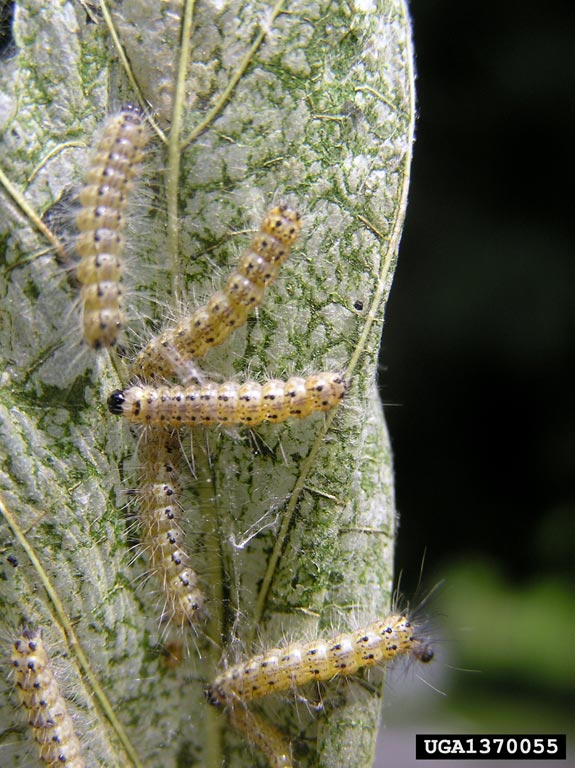 Fall Webworms - November 27, 2013 Jeff Schalau, Agent, Agriculture & Natural Resources University of Arizona Cooperative Extension, Yavapai County Fall webworms (Hyphantria cunea) have been feeding on cottonwood, sycamore, alder, fruit trees, and other deciduous trees in the Verde Valley area since mid-summer. They prefer riparian corridors and became more noticeable in September because it’s the second generation. Fall webworm infestations bear some resemblance to tent caterpillar (Malacosoma spp.) infestation in that they create and live within silken webs at the ends of hardwood branches and feed on the foliage (tent caterpillars are active in the spring). Even though fall webworm feeding appears to damage the plant, their long-term impact is not usually severe. Fall webworms are native to North America and Mexico and can produce one or two generations per year. Adult moths emerge from overwintering pupa in the spring. After mating, females lay masses of eggs (400 to 500) on the undersides of suitable host tree leaves. The larvae feed in colonies in web enclosed foliage. They begin by constructing small webs near the ends of branches and gradually increase the size of the web as the need for food increases. Mature caterpillars are yellowish with black and brown markings, and have many tufts of long hair. Feeding continues for four to six weeks. Mature larvae crawl down the tree and pupate in the litter on the ground. Pupation normally occurs in June with the adults of the second generation appearing in late June to early July. These adults mate and the female lays eggs on the underside of the leaves. Second generation larvae are usually present from late July through late September. As larvae mature, they crawl down the tree and spend the winter as pupa in the leaf litter under the tree. The first generation is often small and usually goes unnoticed. The second generation is much larger and more noticeable. Fall webworms are found more often on trees that are not surrounded by other trees. High populations of fall webworm can completely defoliate host plants but do not kill them. However, on pecan trees, nut production and quality can be reduced if webworms are not controlled. Pruning and destroying the infested portions of branches is a common control practice while webs are still small. Also, a stick or pole with a nail inserted crosswise can be used to snag individual webs. Twisting the pole after insertion will cause the web to wrap around the pole where it can be removed and bagged or burned. Spraying the webs with water at high-pressure can also disrupt feeding and reduce webworm numbers. Controlling webworms by pruning can also be considered but may ruin the shape of the woody ornamental plant. Various species of natural enemies help to manage this native insect. Birds and many insect predators and parasitoids (often wasps or flies) attack the larval stage. Eggs may also be destroyed by predators and insect parasitoids. Over 80 species of parasites and predators have been identified in North America. Social wasps (yellow jackets and paper nest wasps), birds, predatory stink bugs and parasitic flies and wasps are the most important. Conventional insecticide sprays are not recommended for home landscapes as they will disrupt predators and parasites that control the webworms and pose unnecessary risks to other beneficial and benign insects. Bacillus thuringiensis (Bt) sprays are a safer alternative in home situations where webworms are creating a nuisance or damaging a crop. Bt is quite effective against fall webworms if it is applied when the larvae are small. Use formulations with UV protectants and thoroughly cover leaves next to nests. As these leaves are incorporated into the nest and eaten, the Bt will be ingested. Commercial producers may decide to use chemical sprays to protect fruit and nut crops. Locate nests early and merely wet the nest and cover nearby foliage. Carbaryl is labeled for fall webworm. Some systemic insecticides (acephate) are labeled for use on fall webworms, but they are not labeled for use on edible crops. As usual, you may find additional information on fall webworms with the on-line version of this column. As a reminder, Cooperative Extension is still accepting applications for the 2014 Master Gardener Training Course. Master Gardeners are volunteers that share science-based horticultural practices and diagnose plant problems in partnership with Cooperative Extension. The weekly 3 ½ hour sessions (9 am to 12:30 pm) will be held at the Yavapai College Clarkdale Campus between January 29 and May 14, 2014. Applications and information for the 2014 Master Gardener Training Course are available on-line at: http://ag.arizona.edu/yavapai/2014MG/. Follow the Backyard Gardener on Twitter – use the link on the BYG website. If you have other gardening questions, call the Master Gardener help line in the Camp Verde office at 928-554-8999 Ext. 3 or e-mail us at cottonwoodmg@yahoo.com and be sure to include your name, address and phone number. Find past Backyard Gardener columns or provide feedback at the Backyard Gardener web site: http://cals.arizona.edu/yavapai/anr/hort/byg/. Additional Resources Fall Webworm, Utah State University Cooperative Extension http://extension.usu.edu/files/publications/factsheet/fall-webworm2010.pdf Fall Webworm, Texas A & M Agrilife Extension https://insects.tamu.edu/fieldguide/cimg314.html |